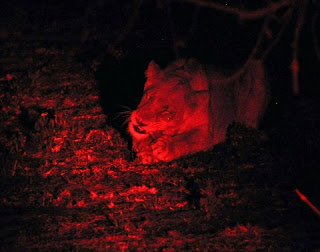The proprietor there was very helpful and the “dorms” were actually rooms with a single bed. It was the first time since Ethiopia that we each had our own room.
From Old Bridge, we took a two-day Mokoro trip through the Delta. Mokoros are the old-fashioned, traditional dugout boats. These ones were made out of fiberglass. Our guides paddled the mokoros through “highways” between the tall reeds and lily pads. It was very peaceful (and beautiful).



They paddled to an island where we set up camp.

By the time we got there, we were so excited about getting food that we did not immediately jump up and run to see the elephant that our guides pointed out to us. Our guide thought something was wrong with us. It wasn’t the last time, I’m sure, that he had that thought.
After lunch (and going to see the elephant), Regina and I tried our hand at paddling the mokoros.

We told the guides that we were going to the swimming spot that they had pointed out to us on our way to the island. We assumed that because our guides let us go off alone, it was safe. This, apparently, is not an accurate assumption in Africa. Regina and I got so frustrated trying to steer the mokoro, we decided to swim in the first decently-sized hole that we could find. The water was very clear, and we could not see anything in the water but reeds and underwater plants. We jumped in. About two minutes later, another guide paddled up and asked us if we could touch the bottom. When we said no, he told us to get back in the boat. He wouldn’t explain why until we got back in. Apparently crocodiles prefer deep water because they like to drown their victims and, after the victim has had a couple of days of getting softened up by the water, the crocodiles come back and eat their victim. Oops! We followed that guide to the correct swim spot and had an enjoyable afternoon floating and splashing in the Delta.
About an hour before sunset, we headed out for our walking safari. Unlike the walking safari in Zambia, this guide, Lee, was not carrying a gun. The only thing he had with him was his cell phone, which I very much doubt would help us in any run-ins with elephants or lions.




During that walking safari, and the one the next morning, we saw lots of elephants and birds; some new types of antelope; lots anteater hills, which look more like huts or fire kilns; and, my favorite from this trip, very colorful dragon flies.





At night, we roasted marshmallows and told jokes with our guides.
We liked Old Bridge so much that we decided to stay one more night after the mokoro trip before heading to Namibia. We spent the day with our new friend Dave, shopping for food that we foolishly thought we would not be able to find in Namibia. Ha! That evening, one of the locals was getting very drunk at the bar in rememberance of his dear mum, who had recently passed. He was very nice, but some of his friends (one in particular) were obnoxious and aggressive. It was very cute to see Kaitlin step in to protect me. After that was resolved, we got a dance lesson and had a good time hanging out with the group. It was in that setting that we met Alex, a nice french guy that had just arrived at Old Bridge and who had seen our (handwritten) sign seeking a fourth person to share car rental costs with us during our trip through Namibia. Little did we know that this brief encounter would end up altering the rest of our trip . . .

























